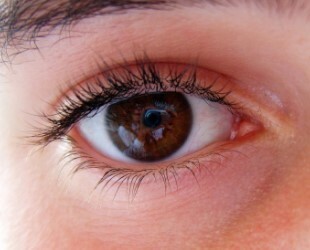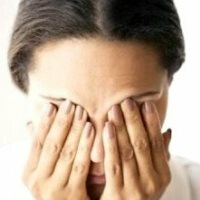
Eyes are the most important human sense organ. If in their work there are any failures and disturbances, this leads to discomfort. To our eyes normally perform their function, they need constant moisturizing.
If it is absent, changes in eye pressure begin. It is reduced or increased - all this leads to poor eyesight.
What is eye pressure? It is also called an ophthalmotonus, it supports the spherical shape of the eye shell and nourishes it.
Ophthalmic pressure is formed in the process of outflow and inflow of intraocular liquids. If the amount of fluid exceeds the norm, the pressure inside the eyes is increased.
- 1. Eye pressure standard
- 2. Daily tonometry
- 3. Treatment of intraocular pressure
- 4. How to reduce eye pressure without the use of drops
- 5. Prevention of eye pressure deviations
Eye pressure standard
Ophthalmotonism of an adult is normalshould not exceed 10-23 mm Hg. Art. This level of pressure allows you to maintain microcirculatory and metabolic processes in the eyes, and also maintains the normal optical properties of the retina.
Reducing eye pressure is very rare, mostly impaired functionality of the eyes are associated with increased pressure inside the eye. Problems with pressure inside the eye begin more often in patients who have reached the age of forty. If you do not take timely measures to normalize it, you can get glaucoma.
It should be borne in mind that during the day IOP( intraocular pressure) may fluctuate. So, for example, in the morning it is higher, and by the evening it gradually decreases. As a rule, the difference in the indices is not more than 3 mm Hg. Art.
Correct the ophthalmotonus with the help of medicines, but for a positive effect it is necessary to get used to their eyes. In addition, drugs are selected strictly individually, it happens that the patient tries several types of them, but there is no effect.
Lowered pressure inside the eye or eye hypotension
Reasons for lowering IOP:
- Lowering blood pressure. Scientifically proven, arterial and intraocular pressure between themselves are closely related. When hypotension occurs, a decrease in pressure in the eye capillaries, and as a consequence - a decrease in IOP.
- Complications after surgery.
- Pathologies of an inflammatory eyeball( iritis, uveitis, etc.)
- A foreign body or an eye injury can lower IOP and cause an apple atrophy in the eye.
- Dehydration that occurs with severe inflammation and infections( peritonitis, dysentery, cholera).
- Kidney Diseases.
- Retinal detachment. Undeveloped eyeball.
Symptoms of eye hypotension
If the cause of depression is dehydration, inflammation or infection, then the pressure drops dramatically, the patient's eyes stop shining, become dry, and sometimes even eyeballs fall.

If the ophthalmotonus decreases gradually over a long period of time, then, as a rule, the symptoms are practically absent. The only thing that a patient can notice is that his vision is gradually deteriorating.
Increased intraocular pressure or ophthalmic hypertension
Elevated pressure inside the eye is of three types:
- Stable - IOP is permanently above normal. This pressure inside the eyes is the first sign of glaucoma.
- Labile - IOP increases periodically, and then again takes normal values.
- Transient - IOP increases once and has a short-term character, and then comes back to normal.

Read more about the disease of the retina - angiopathy of the retina. Learn how to correctly diagnose and effectively prescribe treatment.
Detailed instructions on the correct treatment of an unpleasant eyelid disease - demodectic.
Reasons for an increase in IOP
The most common cause of increased eye pressure of a transient species is hypertension. Also, the pressure in the eyes can increase due to their overwork, for example, with prolonged work at the computer. Most often in parallel with the ophthalmotonus, intracranial pressure also increases.
Often, the cause of IOP increase may be stress, malfunction in the nervous system, heart failure, kidney disease, Basedova disease, hypotension, violent menopause, poisoning.
Elevated eye pressure of a stable variety occurs primarily in the presence of glaucoma. Glaucoma develops, as a rule, in 40-year-old patients and older. Symptoms of increased eye pressure:
- Impaired twilight vision.
- The deterioration of vision is actively progressing.
- The field of vision is significantly reduced.
- Eyes get tired too quickly.
- Redness of the eyes is observed.
- Intense headaches in the area of the supernumerary arches, eyes and temporal zone.
- Flies moths, or rainbow circles in front of your eyes when you look at the light.
- Discomfort when reading, watching TV or working on a computer.
Daily Tonometry
One of the most important medical procedures for detecting glaucoma at an early stage is daily tonometry. It consists in the daily systematic measurement of eye pressure in the morning, in the middle of the day and in the evening. The duration of the procedure varies from seven to ten days.
Methods of conducting daily tonometry:
- using Goldmann's applanation tonometer;
- with a Maklakov tonometer;
- using various contactless devices for measuring eye pressure.
As a result of daily tonometry, an evaluation of the obtained pressure values is made, as a result of which the doctors draw certain conclusions.
Treatment of intraocular pressure
Modern diagnostic methods allow to avoid various complications of increase and decrease of eye pressure - atrophy of eye tissues, glaucoma, etc. Physicians are strongly recommended to perform the procedure of eye pressure measurement at least once every three years( patients from 40 years old).
Treatment of ophthalmotonus depends on the causes that provoked it. If the cause is a certain disease, then only with complete cure it is possible to bring the eye pressure back to normal. If the cause is any eye pathology, then the treatment will be handled by an ophthalmologist, appointing the necessary eye drops.
When glaucoma, the doctor prescribes the administration of drugs designed to reduce ocular pressure( pilocarpine, travaprost, photyl, etc.).Often during treatment, an ophthalmologist replaces the drugs used.
 When diagnosing eye diseases of an inflammatory nature antibacterial drops are prescribed.
When diagnosing eye diseases of an inflammatory nature antibacterial drops are prescribed.
If the reason for increasing the ophthalmotonus is a computer, so-called.computer visual syndrome, the doctor prescribes drops, moisturizing the eyes( vizin, otolik, etc.).They remove the dryness and fatigue from their eyes. Self-administration of such drugs is permitted.
In addition, eye gymnastics and vitamins necessary for vision( blueberry, complement, okuvate, ophthalmos, etc.) are prescribed.
If treatment with medical drugs does not give positive dynamics, then resort to laser pressure correction, or microsurgical operation.
Drops from eye pressure
These drugs quite effectively normalize intraocular pressure. They feed the tissues of the entire eye, remove excess fluid from the eyeball.

In the article, you will find out the reasons and methods of treatment with rezi in the eyes.
Here you will find out what symptoms are manifested with barley eyes.
Worried about the nervous tic of the eye? Learn the main reasons - http: //moezrenie.com/simptomy/ dergaetsya-glaz.html
In general, droplets from IOP are divided into several types:
- Prostaglandins - increase the flow of intraocular fluid( Tafluprost, Xalatan, Travatan).They are quite effective: after instillation after a couple of hours, the pressure decreases markedly. They have, unfortunately, side effects: the color of the iris changes, redness of the eyes, rapid growth of the eyelashes.
- Holinomimetiki - cuts the eye muscles and narrows the pupil, which significantly increases the amount of outflow of the intraocular fluid( Carbocholine, Pilocardin, etc.).Also have side effects: the pupil becomes narrow, which significantly limits the visual field, as well as provokes pain in the temples, eyebrows and forehead.
- Beta-blockers - designed to reduce the amount produced in the eyeball fluid. The action begins in half an hour after instillation( okumed, okulol, timolol, ocupress, arutimol, etc.).Side effects of these drugs manifest themselves in the form of spasm of the bronchi, a decrease in the contractions of the heart. But there are beta-blockers, such as beta-optic and beta-optic, having a much less pronounced effect on the heart and respiratory organs.
- Inhibitors of carbonic anhydrase - designed to reduce the amount of produced intraocular fluid( Trusopt, Asopt, etc.).Such medicines do not have a negative effect on the work of the heart and respiratory organs, but patients with renal diseases should be treated with extreme caution and only for medical purposes.
Drug treatment of intraocular pressure can be supplemented with folk medicine. It offers many different decoctions, compresses, lotions and infusions. The main thing is not to forget about eye hygiene and treatment, which was prescribed by a doctor.
Problems with eye pressure can lead to serious visual impairment or, in general, to blindness. Therefore, it is necessary to visit the ophthalmologist on time in case of slightest deviations in the work of the organs of vision. In time, the treatment begun and modern diagnostic methods will help restore vision back to normal.
How to reduce eye pressure without the use of drops
Eye pressure can be reduced without the use of medications. Long walks in the fresh air contribute to reducing eye pressure due to oxygen saturation of the body.
Proper nutrition with foods containing omega-3 fatty acids, vitamins and minerals normalizes the pressure inside the eyes. Also for excellent health it is necessary to limit the consumption of salt as much as possible.
Folk remedies are also an excellent way to reduce eye pressure. Broths from the clover of the meadow, golden mustache quickly correct the eye pressure.
Stressful situations and nervous overload significantly increase eye pressure, so they should be avoided as much as possible.
Prevention of eye pressure deviations
Any disease is better to prevent in time than to treat for a long time. One of the preventive measures is first of all a regular visit to the ophthalmologist, who will measure eye pressure.
The main ways to prevent eye pressure abnormalities:
- Daily gymnastics for the eyes.
- Regular exercise.
- Quality rest.
- Complete nutrition.
- Admission of vitamin complexes.
- It is necessary to rest your eyes, do not strain your vision excessively.
- Moderate consumption of beverages high in caffeine.
- Full refusal of alcohol.
